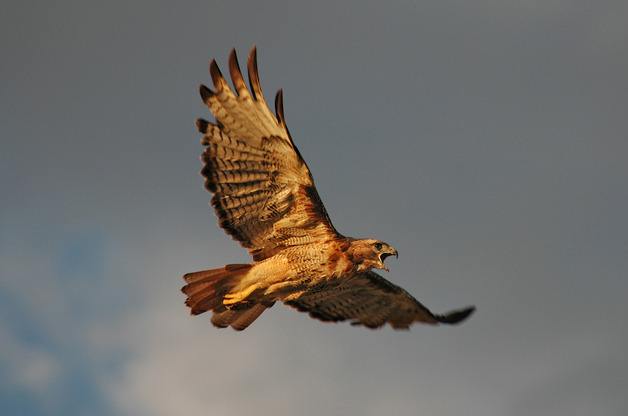January’s a good time to watch for that other winter raptor, the one that is smaller and browner than the familiar bald eagle. I’m sure you know its name, but can you identify the red-tailed hawk? Especially when it doesn’t have a red tail?
Red-tailed hawks live here year-round, but in fall many more leave their northern breeding territories and look for winter feeding areas. Hundreds of them settle into wide open areas, such as the Skagit Flats, and a fair number are satisfied with Whidbey’s open fields and grassy margins.
Right now we have many of these football-shaped, mid-sized raptors sitting on power poles, tree branches along Highway 525 and maybe even perched above your bird feeders. A pair of red-tailed hawks sometimes sits in the lone, bare-topped cedar tree close to the highway at Greenbank Farm. There’s another that often settles in a tree across the highway from Whidbey Island Bank in Freeland.
According to Robin Clark, who works on wetland restoration with Whidbey Watershed Stewards, those tall poles located in the open area on the eastern side of Cultus Bay Road, a bit north of where French Road intersects, were installed as raptor perches and have already been claimed by red-tailed hawks.
Typically it’s the Cooper’s and sharp-shinned hawks that hunt for the small birds that visit our bird feeders. However, this winter my husband has noticed a red-tail resting in a dead snag outside his home office, above where a suet feeder hangs.
One morning the red-tailed hawk was hunkered on the ground right under the feeder, wings spread around its head claiming and protecting a recent kill, probably an unsuspecting junco. The bird stayed in position while my husband walked slowly into the office. 
When hunting for food, these birds adopt a sit-and-wait posture. They can pick out a mouse from 100 feet in the air. When prey enters their strike zone, they drop like a bullet and seize their meal with their talons. They’ll eat small to medium sized mammals, birds, snakes and even large insects.
Most of our adult red-tails are deep chocolate brown with a dark head, pale creamy chest with a dark bellyband and a russet red tail. White spots on the birds’ scapulars help with identification when viewing the bird from behind.
Males and females look similar. It’s the juvenile birds that might confuse you, since they don’t get their red tail until they obtain sexual maturity at about 4 years of age.
Red-tails are found all across the United States and southern Canada. The species is highly variable throughout its range and some authorities recognize up to 16 subspecies. Those subspecies vary in coloring, from completely dark brown — even the tail — to very pale cream with a light reddish tail. This makes the hawk somewhat difficult to identify.
I recommend that birders learn to depend on the bird’s size, shape, call and specific identification markings, rather than overall coloring for identification.
During breeding season these hawks become very acrobatic. Both the male and female perform spectacular aerial maneuvers accompanied by shrill cries. A few years ago, my husband and I observed such a display while driving along Wilkinson Road near the Comforts’ winery. Two red-tailed hawks circled and called above us.
The male appeared to dive-bomb the female from above, and at the last minute the female flipped over and they locked talons. They flopped and spiraled toward the ground, disengaging at the last minute before safely landing close to each other. When they noticed us, they took flight again.
At first we thought the birds engaged in this fierce display were males fighting over breeding territory. Only when I researched this behavior did I learn that it was part of the courtship ritual.
Of course the bald eagle remains our most commonly seen and majestic raptor. But keep an eye out for the elegant, noble and more mysterious red-tailed hawk. You’ll be amazed how many are wintering with us here on Whidbey.
Contact Frances Wood at wood@whidbey.com
Photographer Craig Johnson, an avid birder and author, can be contacted at Craigjohnson@whidbey.com

